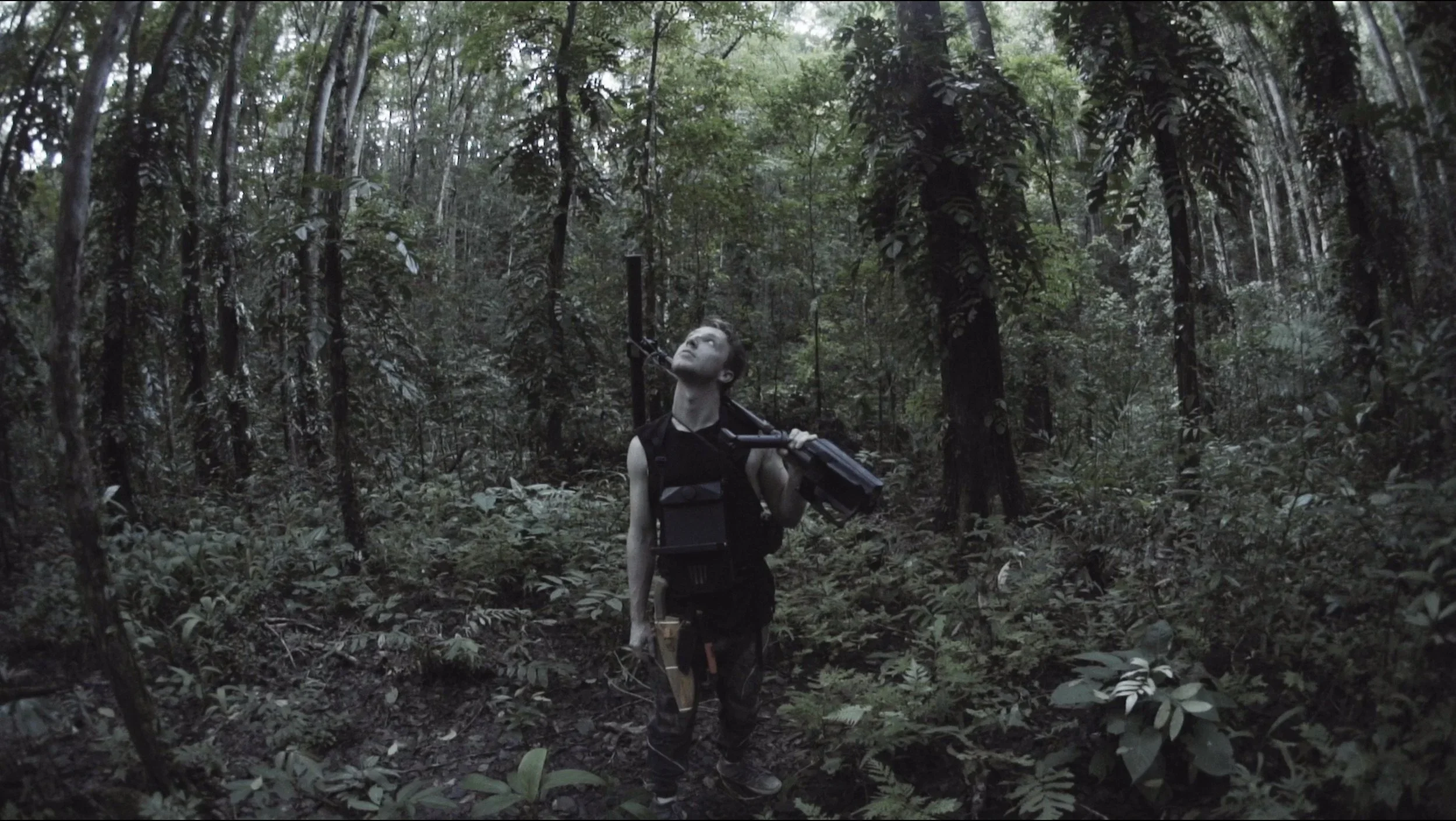16th Pandayang Lino Brocka OMNIBUS REVIEW: Festival In the Land of Ruins
16th Pandayang Lino Brocka OMNIBUS REVIEW: Festival In the Land of Ruins
Pandayang Lino Brocka returns with the selection of this year’s theme “Lupang Sinira”. Finalists are a mix of narratives, documentaries, experimental, and animated short films showcasing various sectors of society — workers, peasants, youth, women, fisherfolk, and others — face distinct socioeconomic challenges and aim to address these injustices, advocating for the rights and interests of marginalized communities. Here are the reviews of the official selection.
OFFICIAL SELECTION
Film still from Sunugin Ang Aparador!
Sunugin ang Aparador!
By Gio Potes
The LGBTQ struggle has already been deemed mainstream and worthy of conversation in recent popular media and culture, but this only goes to benefit the narratives that are commercial or that everyone can play safe or agree to. In other terms, the middle class, which is often associated with coming-out and acceptance stories. These films have become so saturated with filling up stereotypes only the middle class can aspire and dream of that they tend to forget that there have always been marginalized stories that have overlapped with stories of discrimination, such as the case of Gio Potes’ Sunugin Ang Aparador!
Gio Potes doesn’t shy away from his LGBTQ+ radical storytelling in his second feature, Sunugin Ang Aparador! which he begs to differentiate from those conventions above. Sunugin Ang Aparador! tells the story of two queer friends reflecting on their personal closets. Though coming from different backgrounds and struggles, Potes combines these and interconnects them to justify the need to change the system or burn the closet.
Oppression comes in various forms, and this is visually captured, as fiery and bloody as red, in its use of closets that depict what they’ve been afraid of when it comes to narrating their stories. Whether it’s a kind of oppression that has been creeping, begging to be released, or an internal voice that keeps being repeated in its most verbal and haunting expression, the film depicts such experiences incredibly.
The ideas of liberation are contrasted with just what-ifs and imaginations of their ideas of a free society through the use of their imagery of Caloy, which humanizes the choice of burning closets, that even such an act is also a bloody struggle, forcing one either to stay quiet or just flee.
The film analogizes that closets are opened and closed from time to time as they narrate their own struggles, questioning whether coming out suffices freedom when there are still many more they have to encounter due to the established negative connotations that they’ve been facing even before they were born. Potes begs to question the audience if the people are ready to accept this kind of conversation or if they have to wait for them, but instead, he chooses to burn as many closets as he needs to.
Gio Potes’ Sunugin Ang Aparador! can be streamed online at Cinemata.
Film still from Suwelas
Suwelas
By Inaaniko
The primary obstacle to national industrialization is the dominance of foreign corporations. The government prioritizes attracting these corporations over developing the country’s own industries, reinforcing a reliance on agriculture and an export-oriented economy. This reliance undermines local industries, forcing them to compete with foreign counterparts and contributing to further economic decline. Cases like these can often be overlooked due to being labeled as the “Capital” or terms of flourishing multi-million peso industry, which is what Inaaniko’s Suwelas wanted to emphasize.
Though it is probably the lightest in terms of themes among all the entries, it doesn’t mean that Suwelas undermines a history's worth of relevance of the Marikina shoe industry. Suwelas tells the story of the sapateros in Marikina and their challenges in the industry. The premise was already told lightheartedly to understand the case of Marikina’s once-shining shoe capital that everyone had likely already forgotten about. The narrative choice of connecting the origins of the shoe industry and its declining economic state bridges the gap between national industry and history considering how Marikina used to capitalize on this product, making it their cultural heritage, which is also just one example of the government’s negligence in supporting national industries and cultural heritage in general.
Inaaniko’s approach was personal, directly interviewing the sapateros themselves, which also revealed that shoemaking is a common practice among families highlighting how this culture is rooted in familial ties and their perseverance to continue their heritage. Suwelas ended with the need for urgency on what must be done to help cultural preservation while also promoting the national industry. Narratives like these are often overlooked because of their label of “Capital”, which could lead to misinformation on the actual current status of a declined industry. Inaaniko makes this only-once-mentioned-in-the-textbook story into a call to action.
Film Still from Tatlumpu Kami Rito.
Film still from Tatlumpu Kami Rito
Tatlumpu Kami Rito
By Kiara Ricamara
Duterte’s War on Drugs has taken a toll of normalizing extrajudicial killings, even some coming to support it or just fully denying its existence. The number of EJK killings intensified due to a quota system that needed to be reached and this, in return, rewarded the licensed killer. To reach this quota, various forms of violence were committed and the Secret Jail was one of them. It’s very easy to plant evidence pointing to drugs in those times, which led to many blackmails and even self-profiting police stations. These means of silence further reduce their lives to just numbers to reach this quota. Although these narratives are not new, Kiara Ricamara’s Tatlumpu Kami Rito pushes to keep this conversation alive.
The resulting dehumanization from the “War on Drugs” pushes storytellers like Kiara Ricamara to see it as more than just a part of history, but more as a phenomenon that impacted the very fabric of Filipino society’s values. Tatlumpu Kami Rito tells the story of two men reminiscing about their lives before they were thrown into a secret jail. The direction started messy and felt forced on how these characters connect especially when they just met and sort of created a bond after fighting and suddenly started retelling their life experience before all of this.
The horror visuals from its faceless characters to their eyes and mouths being brutally scoured in that dark room with the lack of any background story just show how lifeless the setting is, or they might even be already dead. Tatlumpu Kami Rito attempts to humanize the lives of these victims, saying that they’re just more than numbers of the quota but they are lives who also struggled to live in this country, further emphasizing the anti-poor campaign of the “War on Drugs.” It’s tragic, and this is what Ricamara wanted to tell. The short film manages to examine the perspective of the outside world, the ones who gaze and the ones who became monsters that took matters into their own hands. Justice is still questionable, especially the impact of this dominant narrative of normalizing extrajudicial killings which Ricamara begs the audience to empathize with these lives and to address this has slowly crept into becoming the new normal.
Kiara Ricamara’s Tatlumpu’t Kami Rito can be streamed online at Cinemata.
Film still from SAMASA
SAMASA
By Ian Peter Guanzon
Martial law stories have become oversaturated because of the need to combat historical distortion. Often than not, they tend to replicate conventions just to keep the conversation going and alive. There’s nothing wrong with this approach since the intent is still there to combat dominant narratives that have now reshaped how martial law is seen. The effectiveness of this propaganda of the golden age is rooted in how most mainstream struggles narrated are centered in Manila, lacking that sense of collective national trauma that martial law caused the country. 11,103 was monumental in their approach to martial law, focusing on victim-survivors, highlighting stories from Visayas and Mindanao and how martial law remains a harrowing memory to both activists and those baselessly targeted as of the present. Ian Peter Guanzon’s SAMASA follows the same approach of 11,103, contributing to the need for more historical accounts.
This decentralized the idea of Manila being the center of protest, contributing to the need to mainstream the identity of Cebu and being a hotspot of protest back in martial law. Guanzon’s approach is the same as 11,103, it heavily relies on victim-survivor storytelling, complemented by animations of their past accounts. It is noteworthy how it also tackled the devastating effects of martial law on them despite how, at the time, most of the survivors were still children and had to recount their hounding nightmares. Moreover, they recalled how they were treated by society for being targeted by the military.
The film was able to mention how past narratives of people at the time of martial law were already stigmatized and labeled subversive and how these perceptions, in turn, lead to the worst for them, losing the lives they deserve, such as being able to finish school and, in the end, struggling in poverty up until the present. Guanzon made it clear that accounts like these can otherwise be interpreted as silent or easily dismissed, yet these people are internally still recovering from trauma, hence the need for additional platforms for regional narratives that can help deepen the understanding and acknowledgment of collective national trauma that martial law has brought upon the country.
Film still from Pitik Ng Paglaya
Pitik Ng Paglaya
By Zedrich Xylak Madrid
Media censorship transcends through time even before, during, and after martial law. The essence of democracy comes with press freedom and censoring it already means the oppression of democracy itself. Photojournalists, in their photographs, captured the emotions and truth in history. It is one way of showing the masses the events to read more than just the lines of the print but also to see and feel the story and be enlightened of the harrowing realities it is situated in by simply looking at the photo. These actions don’t allow them to be succumbed to oppression which is why Zedrich Xylak Madrid’s Pitik Ng Paglaya is a love letter to photojournalists.
Hearing the truths from the victims is different when seeing the truths in photos. Capturing a moment in time and everything in it is already a story to tell and it is more than just a snapshot of time. Pitik Ng Paglaya tells the story of three photojournalists in different historical eras. Although media censorship did not really end with martial law, it could be explored more in its aftermath or its state during past administrations to not limit the idea that media censorship only occurred during the time of Marcos and Duterte.
Zedrich Xylak Madrid’s intent for this documentary is to not romanticize photojournalism because it devalues its essence and role in a democracy, especially in times of state oppression. Romanticizing it would ignore the realities these photojournalists have to endure, from intimidations to death threats, all of which are felt in their day-to-day lives. Pitik Ng Paglaya further emphasizes this by retelling the narratives of those eras and how they were oppressed by state forces but continued doing their cause albeit risking their lives. Their cause is more than just taking photos; it’s to capture the truth. Madrid ends it with a hopeful note that these actions contributed to the Filipino’s resistance to oppression and shows the value of photojournalism in protecting democracy.
Film still from Tingog sa Carbohanon
Tingog Sa Carbohanon
By Lance Christian Gabriel
Community displacement narratives due to development aggression just summarize how the capitalist government vows in favor of private corporations. This in return villainizes the identity of the displaced community as just trash-needed-to-be-cleaned in that area rather than just victims of poverty that they are forced to live in with. Displaced communities are seen everywhere; whenever there’s a new private establishment in the area, it is already known that there is displacement happening or it has already happened. Lance Christian Gabriel’s Tingog sa Carbohanon invites the audience to witness their struggle and first-hand experience of oppression.
If there’s anything to describe the whole motive of this documentary, it’s that the film wants to expend raw energy of anger from being unrightfully displaced. Tingog sa Carbohanon tells the story of the Carbon Market vendors and their rights to protect their stalls from oppression. Lance Christian Gabriel, for the duration of the short, captures the Carbon Market vendor’s anger, frustration, and suffocation accumulated by the unrelenting circus of oppression. The film also begs the question of why the privatization and development— whose intention is to turn the Carbon Market into a world-class commercial hub— feel the need to justify the displacement of the working-class community that has presided there, to secure an ideal image of first-rate commerce. In its already short time length, it has explored the many facets of oppression and discrimination faced by these vendors. What’s tragic about it is how the world reacted to the prejudice against them, calling all forms of intimidation to reduce the vendors’ humanity and villainize their struggle. This, in turn, leaves audiences questioning why society hates the poor so much that they forcibly remove their ways of living and prosper without providing them helpful alternatives, y and treat them worse than the disposable trash that can’t be segregated.
Film still from Panatag
Panatag
By Allan Lazaro
Sovereignty disputes have always been messy and could lead to anything from the worst you can expect, especially when the country you are fighting is a superpower. In this case, the West Philippine Sea sovereignty has always been contested, primarily by the People’s Republic of China, which begs the question of the total power of international laws. Despite favoring the Philippines, China still contested these waters, absolutely violating the said agreement. Even now, humanitarian efforts are filled with conversations on imperialist propaganda, such as being framed as spies of the US, dismissing the agency of human rights workers. China continues to destroy the very fabric of the marine environment for their national demand, heavily affecting the fisherfolk. The fishermen residing in these waters have become the punching bag of this ongoing maritime conflict, which is why they are the primary focus of Allan Lazaro’s Panatag.
Everything presented in the documentary is so harsh that it feels like one cruel ironic joke, even the name of its place is ironic. Panatag tells the story of the fisherfolk who once used the shoal as their fishing area but were forced to find alternative livelihoods due to the intrusion by Chinese vessels. Allan Lazaro plays stories with intersecting narratives of what was once hope for them. They see the shoal as more than just their source of living; it’s their shelter when the weather goes bad. The idea of hope through bringing safety and security is now threatened by the intrusion of Chinese vessels. Panatag explored the personal aftermaths of each fisherfolk after having their security threatened by China, and this is presented by retelling what inspired them initially to fish and how they are now forced to find even the littlest alternatives just to feed a mouth every day for their families. Lazaro aimed to spotlight the struggles of fisherfolk, highlighting their plight rather than delving deeply into the diplomatic tensions between the countries involved. While exploring these geopolitical dynamics could provide additional context, it risks presenting the issue as overly fragmented. Despite this, the documentary prioritized the profound impact on the lives of the fisherfolk over offering a detailed political analysis.
Film still from Dalangpanan
Dalangpanan
By Zhynnon Mar Mantos
Four stories from Cebu entered this year’s official selection and each had its narrative approach to the many social issues and human rights violations present in the area. The next two entries, made by the same production team, aim to paint Cebu as this socio-mythical place rooted in injustice. Amid escalating developmental aggressions, myths can reshape perceptions of a place, framing it as property to be claimed and labeling its inhabitants as illegal settlers taking turns for the worse as being forgotten and desolate cases. Such myths create false beliefs about a home. This perspective appears to underpin the reclamation portrayed in Zhynnon Mar Mantos’ Dalangpanan.
The marginalized have taken it for the worse for choosing to settle in an area that automatically labels them as illegal settlers as Shell Island is already being bought. Losing for them means losing their home altogether, and chances of relocation are entirely questionable. Dalangpanan tells the story of the settlers of Shell Island. Shell Island was once just a temporary fishing shelter and now turned into a harbor settlement for marginalized fisherfolk. Stories like these have finally been given the spotlight on what it is like living in extreme conditions, and how they’re not being considered for relocation by the local authorities. The film’s remarkable cinematography, highlighting Cebu’s development and infrastructure in both backgrounds and foregrounds, paints a picture of how many of these communities have been left out due to the government prioritizing more commercial and capitalist interests, even allowing the interested to claim the area. Mantos uses the word, ‘illegal,’ here a lot but this is what makes the Shell Island as a home a myth which makes the marginalized fisherfolk's idea of home just a false belief and this is what drove the capitalist corporates to claim the area for their own leaving the marginalized fisherfolk nothing for themselves as the terms align with the law. Dalangpanan are able to shed light on their own personal narratives, seeing the place as more than a myth but as their home, and understanding the harsh realities of how they ended up in the area, as a result of the government’s lack of interest overall.
Film still from Kon Mahunong Ang Sulong
Kon Mahunong Ang Sulong
By Zhynnon Mar Mantos
Development aggression seems to be the most common topic out of all the entries, and this just shows how this issue does not only occur in one place. This is taken for the worse of how development aggression intersects with other sectors such as Indigenous communities leaving to be involved out of their will. This case of Indigenous communities who have no one to seek help to, turn to their beliefs as their way of hope and resistance in these times. However, the myth of the wrath of nature can be interpreted in a lot of ways in a socio-mythical context, considering that the most recent causes of destruction are all and entirely anthropogenic, which is the approach of Zhynnon Mar Mantos’ Kon Mahunong Ang Sulong
The most divisive out of all the entries, the film uses myth as a double-edged sword in telling their realities. Kon Mahunong Ang Sulong tells the story of a series of unfortunate events in the province after an eerie encounter in the river. The short film reveals that it is not a curse that caused their misfortune, but instead, the reason is man-made destruction. Beliefs being the reason for their misfortune is a divisive take on how innocent lives are affected. However, beliefs shouldn’t be blamed because the idea behind the reasoning tends to villainize Indigenous communities’ beliefs, which is what Western ideologies tend to usually do. Instead, the best course of thinking is to understand their innocence in the whole situation. Kon Mahunong Ang Sulong is brave in exploring myths to show both sides of the story to empathize with them, not to dumb them down and blame their own culture for their downfall.
Film still from Bughaw, Dilaw, Magugunaw!
Bughaw, Dilaw, Magugunaw!
By Gerard Bernardo
Revolution remains a taboo subject, often misunderstood or deliberately avoided. Yet, a deeper understanding requires confronting the genuine causes of such struggles, particularly in a society entrenched in ignorance. Failure to address these systemic issues not only perpetuates injustice but also silences the rights of marginalized sectors, especially those advocating for genuine agrarian reform. When fact-checking has already been seen as a tireless act and of a savior complex, educators have to rely on storytelling to bridge the gaps of this ignorance such as in the case of Gerard Bernando’s Bughaw, Dilaw, Magugunaw!
The short film can be deemed animated or comedic, but the narrative choice for it is still one of the major taboos caused by ignorance and disinformation that made Gerard Bernardo feel the need for his approach to be more accessible in learning these narratives. Bughaw, Dilaw, Magugunaw! tells the story of two soldiers trying to gain control of a land and the farmer who belongs to that land. Too blind or self-fulfilled by their greed, the two soldiers, representing the capitalist corporations, exhausted their militarization efforts to seek control of the land. The presence of the third character, the farmer, exists in the periphery as the game continues as they’re not allowed to take part. Fully shoving out the farmer’s involvement concerning their land just shows how unconsented development aggressions are. In the animated fight scenes, aggressive militarization pressure on both sides depicts how innocent lives stuck in the middle are forced to be victims of their agendas. The comedic silent flare emphasizes that these grandiose devastating actions have impacts that don’t need talkies or further explanation of the situation, and it is either, we laugh about it or be concerned about it afterward. It doesn’t necessarily have to be in-depth when knowing narratives of resistance, but Bughaw, Dilaw, Magugunaw! manages to recontextualize the story that even an elementary kid can understand. Bernardo ends the short film by giving understanding and justice to the need for revolutionary resistance in these times in the most G-rated rating possible.
16th Pandayang Lino Brocka will be announcing future dates of screenings.























